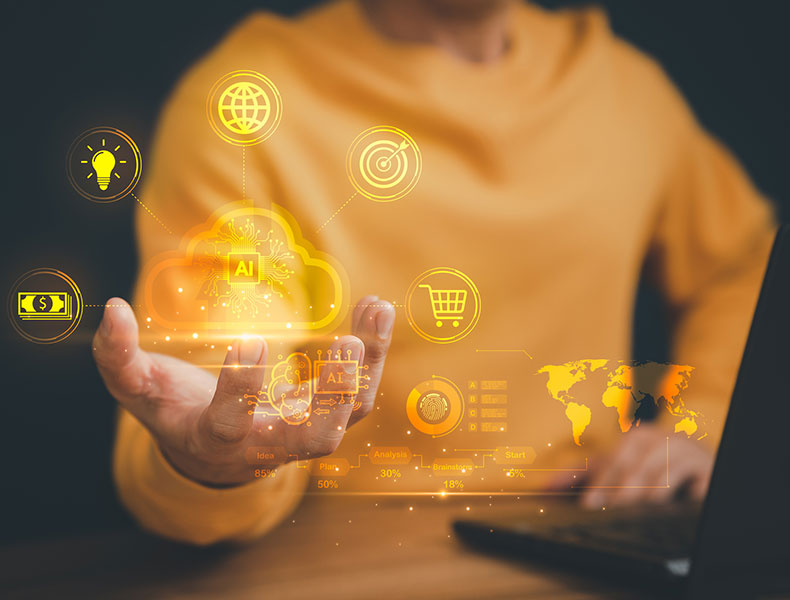Food Technology Magazine | Digital Exclusive
AI Advances Product Development
CPG companies including PepsiCo and Kraft Heinz, among many others, are using generative artificial intelligence to support product development.

© jpkirakun/iStock/Getty Images Plus
Artificial intelligence (AI) hasn’t yet reached the point where it can effectively advise CPG and foodservice product developers on what to do next—whether to substitute stevia for sugar in a beverage, swap peanut butter for almond butter in a protein bar, or tweak the recipe for the aioli in the Chef’s Special.
But AI is getting closer. And, yes, the new generative AI is accelerating its pursuit.
Among all the advances AI is bringing to the food industry—more efficient farming, tighter transportation, significant efficiencies in manufacturing, and better matching of inventory to sales at retailers—the most dynamic gains may be coming in product development.
“The days of traditional R&D are pretty much over,” says Ken Harris, managing director of Cadent Consulting Group. “The effect of AI on traditional R&D is to make it obsolete. You have to use AI to stay in the game.”
For instance, the generative AI tool TasteGPT from Tastewise has made Kraft Heinz “capable of doing things that we couldn’t do three years ago, we couldn’t do five years ago, because technology has moved on,” Tom Hadwen, head of sales, foodservice international at Kraft Heinz, told a recent Tastewise summit in London.
“We can understand now what’s happening market by market,” Hadwen continues. “And that’s something that we started to do. We started to understand the trends [much] earlier so we can own what’s happening in the market.”
PepsiCo is using AI to connect “different data sources” to overcome “a lot of the ways that insights are generated today, [which] is very fragmented,” Sioned Winfield, the company’s marketing, insights, and transformation director, told the summit. “But a gen AI can help us to make better connections, so we then as humans can move to more storytelling and engaging and driving that impact.”
Modern AI can give companies vast new, efficient insights into all the facets of the business that affect product development—from nutrition profiles of ingredients to the choices consumers will make at the shelf. It “enables organizations to get a better understanding of customers, to identify and see opportunities they didn’t see in the past, and track evolutions in their market—enabling insights from the data they’re gathering to have significant competitive advantage,” says Harvey Rañola, global head of media intelligence for Quid, an AI startup.
The databases include social media communications, the company’s own market research and other internal sources of information, customer research platforms, investment data, and patents, Rañola explains. “In the past, leveraging traditional means of using this data to create visualization, would take hours if not days,” Rañola says. “Now, it’s instantaneous.”
And, while AI’s output “doesn’t necessarily tell folks what they should be doing,” he says, “it does tell people whether an emerging trend shows indicators of what might be a lasting trend.”
New Partnerships, New Insights
CPG and restaurant companies are rapidly forming partnerships with AI mavens and striking out on their own to harness AI. Mars, for example, is two years into a multiyear agreement with PIPA LLC to leverage the AI startup’s advanced data analytics and bioinformatics to help it design new products with the health benefits that consumers are demanding. PIPA’s AI is able to integrate biomedical databases, scientific publications, clinical trial data, and other information sources to highlight associations among molecular and food-related entities with microbes and diseases. This helps predict connections that can accelerate new product development, Mars says.
PIPA’s help already is creating product development successes using AI, Mars noted in a press release, citing the example of a model that helped Mars to develop a diagnostic tool that predicts kidney disease in cats.
Campbell Soup leapt into AI four years ago, and now generative AI “has the potential to be an exciting new asset,” says Craig Slavtcheff, the company’s chief research and development and innovation officer. “It’s changing the consumer path to purchase, the way we show up and market products, and how we work with partners.” What is key, he says, is “insight and innovation to be able to quickly synthesize consumer data into new concepts and ideas.”
Meanwhile, Danone is using AI to plumb the health possibilities of its library of bacteria to help turn around the sagging fortunes of its global dairy enterprise. Its AI engines use patient samples and profiles gleaned through collaborations with the University of California, San Diego, and other organizations to analyze the microbiomes of hundreds of thousands of volunteers and figure out the likely impacts of various strains of flora.
Many startups are working with ingredient companies and food processors to apply AI to the very origins of food and produce new insights at that level, which can aid product development.
NotCo is wielding an AI-based platform it calls Giuseppe to help developers create plant-based versions of animal-based foods by analyzing products at the molecular level and providing alternative plant ingredients to try to match the taste, texture, and aroma of the originals.
Spoonshot applies AI to leverage food science principles with data relating to the physical and chemical properties of ingredients and to understand how ingredient interactions impact a final recipe.
Brightseed’s AI platform, Forager, helps identify bioactive compounds in crops and other plants, predicts their health benefits, validates those expectations in lab and clinical tests, and helps match the substances to potential applications in foods and ingredients.
For example, Forager found a type of fiber that is now in a gut health product “by searching a former waste stream: hemp seed,” says Brightseed cofounder Sofia Elizondo. “Hemp seed comes in little shells, and they are discarded and at best become animal feed. But they are rich in fiber, good for the gut, and super rich in bioactives that support tightening of the gut lining. We are using AI to literally find gold in waste streams that are very important and proven to support very specific health benefits.”
Ayana Bio applies AI to bioactives even earlier, analyzing hundreds of plant cell lines simultaneously to determine the most promising starting points for growing plants—finding, creating, and scaling complex plant molecules without needing to use agriculture to grow ingredients.
“We identify the best cell lines to produce certain bioactives,” says Weslee Glenn, Ayana’s head of innovation. “With ginseng and cacao, for instance, each time you develop a product, you learn about what needs to be true inside the cell. [Ayana] can alter conditions to replicate the levels you’d find in soil and plants, or change conditions to maximize concentrations of bioactives of interest.
“You don’t have to grow them in the ground and can standardize production of bioactives” for inclusion in supplements, foods, and beverages, Glenn explains. “CPG companies engineer their products for taste and flavor, not health and wellness benefits, but if you have a consistent way to produce bioactives, you may be able to boost the nutritional content of that particular product.”ft




